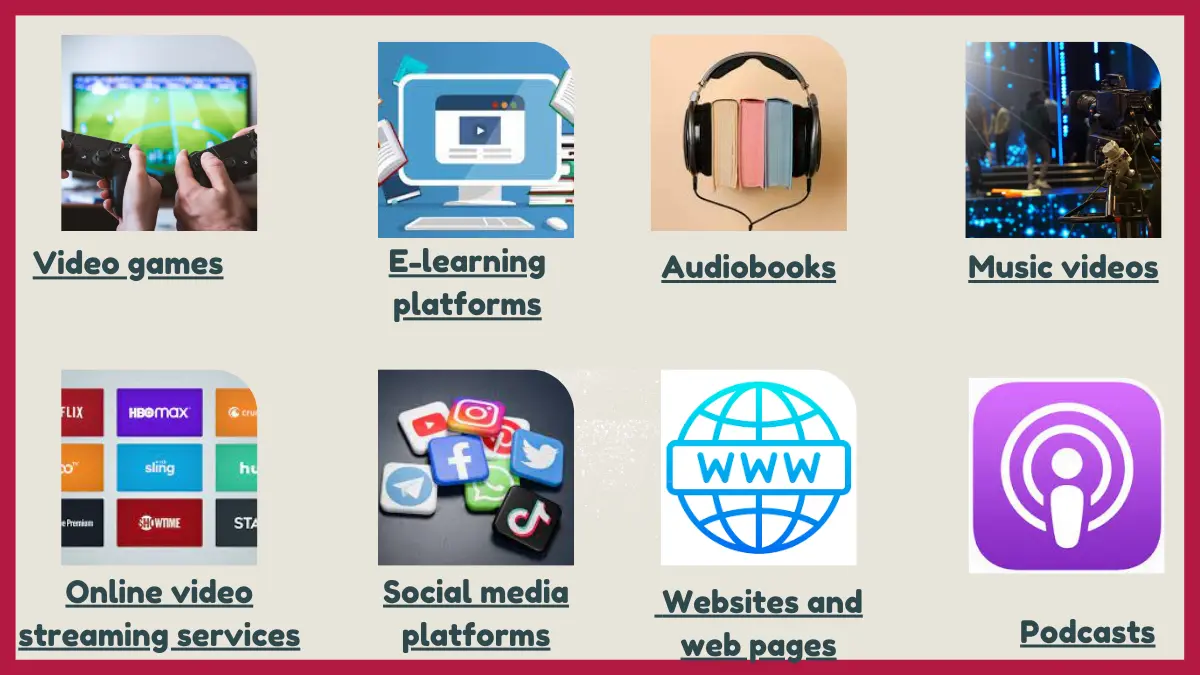Images, audio, video, animation, presentations, websites, e-learning modules, video games, movies, and music videos are a few examples of multimedia.

Examples of Multimedia
Here are some Examples of Multimedia:
1. Websites and web pages
Websites and web pages are some of the most common examples of multimedia. They include a variety of multimedia elements, such as text, images, videos, animations, and audio, to provide a comprehensive and engaging experience for users.
Websites and web pages use multimedia to convey information in a more effective and engaging way. For example, a website for a travel agency may use images and videos of different destinations to inspire users to book a trip. Or, an educational website may use interactive animations and simulations to help students learn complex concepts.
2. Video games
Video games are another prime example of multimedia. They combine all sorts of multimedia elements, including graphics, animation, video, audio, and even text, to create a fully immersive experience for players.
Video games use multimedia to create a world that players can explore and interact with. For example, a role-playing game may use realistic graphics and animation to create a believable fantasy world. Or, a racing game may use immersive audio and video to create the feeling of speeding down a real racetrack.
3. E-learning platforms
E-learning platforms use multimedia to create engaging and interactive learning experiences. They may include videos, animations, simulations, interactive exercises, and assessments.
E-learning platforms use multimedia to make learning more effective and accessible to students of all ages and learning styles. For example, a student who is struggling to understand a concept may be able to learn it more easily by watching a video or completing an interactive simulation. Or, a student who is bored with traditional learning methods may be more engaged in a course that uses multimedia elements.
4. Virtual reality (VR) experiences
VR experiences allow users to interact with a computer-generated environment as if they were actually there. VR experiences often use multimedia elements, such as 3D graphics, video, and audio, to create a realistic and immersive experience.
VR experiences can be used for a variety of purposes, including education, entertainment, and gaming. For example, a medical student could use VR to learn about human anatomy or a surgeon could use VR to train for a complex procedure. Or, a gamer could use VR to explore a new world or play a game from a first-person perspective.
5. Augmented reality (AR) experiences
AR experiences overlay digital information onto the real world. AR experiences may use multimedia elements, such as text, graphics, and audio, to provide users with additional information about their surroundings.
AR experiences can be used for a variety of purposes, including navigation, education, and entertainment. For example, a user could use AR to get directions to a new location or to learn about the history of a building. Or, a gamer could use AR to play a game that interacts with the real world.
6. Podcasts
Podcasts are audio-only multimedia productions that can be downloaded and listened to on demand. Podcasts may include interviews, discussions, lectures, and storytelling.
Podcasts are a popular way to consume information and entertainment on the go. They can be listened to while commuting, exercising, or doing other activities. Podcasts also offer a wide variety of content to choose from, so there is something for everyone.
7. Audiobooks
Audiobooks are spoken versions of books that can be downloaded and listened to on demand. Audiobooks are a great way to enjoy books while you’re commuting, exercising, or doing other activities.
Audiobooks are also a great way to discover new books and authors. If you’re not sure what to read next, you can try listening to an audiobook sample. Or, you can browse the audiobook catalog at your local library or bookstore.
8. Music videos
Music videos combine music and video to create a single multimedia experience. Music videos often tell stories, promote the artist’s music, or simply entertain viewers.
Music videos can be a powerful way to connect with an audience on an emotional level. They can also be a great way to learn about different cultures and perspectives.
9. Online video streaming services
Online video streaming services, such as Netflix, Hulu, and Amazon Prime Video, offer a wide variety of multimedia content, including movies, TV shows, documentaries, and stand-up comedy specials.
Online video streaming services allow users to watch content on demand, whenever and wherever they want. This makes them a convenient and popular way to consume multimedia content.
10. Social media platforms
Social media platforms, such as Facebook, Twitter, and Instagram, allow users to share multimedia content with their friends and followers. Social media users can share photos, videos, and text posts with their networks.
Social media platforms can be used to connect with friends and family, learn about current events, and discover new interests. They can also be used to promote businesses and brands.
11. Presentations and slideshows
Presentations and slideshows can be used to communicate information to an audience in an engaging and visually appealing way. Presentations and slideshows may include text, images, videos, and audio.
Presentations and slideshows are a popular tool for businesses and educators. They can be used to introduce new products or services, train employees, or teach students new concepts.
12. Digital art
Digital art is art that is created using digital tools and technologies. Digital art may include images, videos, and animations.
Digital art can be used to create a wide variety of visual effects, from realistic paintings to abstract sculptures. Digital art can also be used to create interactive experiences, such as video games and virtual reality environments.

